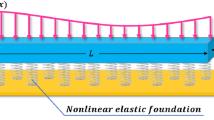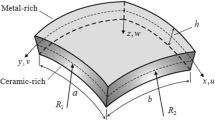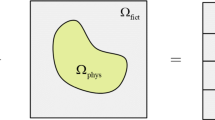Abstract
Heretofore, the Serret–Frenet frame has been the ubiquitous choice for analyzing the elastic deformations of beam elements. It is well-known that this frame is undefined at the inflection points and straight segments of the beam where its curvature is zero, leading to singularities and errors in their numerical analysis. On the other hand, there exists a lesser-known frame called Bishop which does not have the caveats of the Serret–Frenet frame and is well-defined everywhere along the beam center-line. Leveraging the Bishop frame, in this paper, we propose a new spatial, singularity-free low order beam element based on the absolute nodal coordinate formulation for both small and large deformation applications. This element, named ANCF14, has a constant mass matrix and can capture longitudinal, transverse (bending) and torsional deformations. It is a two-noded element with 7 degrees of freedom per node, which are global nodal coordinates, nodal slopes and their cross-sectional rotation about the center-line. The newly developed element is tested through four complex benchmarks. Comparing the ANCF14 results with theoretical and numerical results provided in other studies confirms the efficiency and accuracy of the proposed element.























Similar content being viewed by others
References
Audoly, B., Pomeau, Y.: Elasticity and geometry. In: Peyresq Lectures on Nonlinear Phenomena, pp. 1–35. World Scientific, Singapore (2000)
Bauchau, O.A., Hong, C.: Large displacement analysis of naturally curved and twisted composite beams. AIAA J. 25(11), 1469–1475 (1987)
Bauchau, O.A., Bottasso, C.L., Nikishkov, Y.G.: Modeling rotorcraft dynamics with finite element multibody procedures. Math. Comput. Model. 33(10–11), 1113–1137 (2001)
Bauchau, O.A., Betsch, P., Cardona, A., Gerstmayr, J., Jonker, B., Masarati, P., Sonneville, V.: Validation of flexible multibody dynamics beam formulations using benchmark problems. Multibody Syst. Dyn. 37(1), 29–48 (2016)
Bergou, M., Wardetzky, M., Robinson, S., Audoly, B., Grinspun, E.: Discrete elastic rods. ACM Trans. Graph. (TOG) 27, 63 (2008)
Betsch, P., Steinmann, P.: Frame-indifferent beam finite elements based upon the geometrically exact beam theory. Int. J. Numer. Methods Eng. 54(12), 1775–1788 (2002)
Bishop, R.L.: There is more than one way to frame a curve. Am. Math. Mon. 82(3), 246–251 (1975)
Burke, W.L., Burke, W.L.: Applied Differential Geometry. Cambridge University Press, Cambridge (1985)
Canavin, J., Likins, P.: Floating reference frames for flexible spacecraft. J. Spacecr. Rockets 14(12), 724–732 (1977)
Cardona, A., Geradin, M.: A beam finite element non-linear theory with finite rotations. Int. J. Numer. Methods Eng. 26(11), 2403–2438 (1988)
Dmitrochenko, O., Pogorelov, D.Y.: Generalization of plate finite elements for absolute nodal coordinate formulation. Multibody Syst. Dyn. 10(1), 17–43 (2003)
von Dombrowski, S.: Analysis of large flexible body deformation in multibody systems using absolute coordinates. Multibody Syst. Dyn. 8(4), 409–432 (2002)
Dowell, E., Traybar, J.J.: An experimental study of the nonlinear stiffness of a rotor blade undergoing flap, lag and twist deformations. Aerospace and Mechanical Science Report 1194 (1975)
Dowell, E., Traybar, J.J.: An experimental study of the nonlinear stiffness of a rotor blade undergoing flap, lag and twist deformations. Aerospace and Mechanical Science Report 1257 (1975)
Ebrahimi, M., Butscher, A., Cheong, H., Iorio, F.: Design optimization of dynamic flexible multibody systems using the discrete adjoint variable method. Comput. Struct. 213, 82–99 (2019)
Fan, W., Zhu, W.: An accurate singularity-free formulation of a three-dimensional curved Euler–Bernoulli beam for flexible multibody dynamic analysis. J. Vib. Acoust. 138(5), 051001 (2016)
Géradin, M., Cardona, A.: Flexible Multibody Dynamics: A Finite Element Approach. Wiley, New York (2001)
Gerstmayr, J., Irschik, H.: On the correct representation of bending and axial deformation in the absolute nodal coordinate formulation with an elastic line approach. J. Sound Vib. 318(3), 461–487 (2008)
Gerstmayr, J., Sugiyama, H., Mikkola, A.: Review on the absolute nodal coordinate formulation for large deformation analysis of multibody systems. J. Comput. Nonlinear Dyn. 8(3), 31016 (2013)
Ghiringhelli, G.L., Masarati, P., Mantegazza, P.: Multibody implementation of finite volume c beams. AIAA J. 38(1), 131–138 (2000)
Hanson, A.J., Ma, H.: Parallel transport approach to curve framing. Techreports-TR425 11, pp. 3–7, Indiana University (1995)
Jonker, J.B., Meijaard, J.P.: A geometrically non-linear formulation of a three-dimensional beam element for solving large deflection multibody system problems. Int. J. Non-Linear Mech. 53, 63–74 (2013)
Lens, E.V., Cardona, A.: A nonlinear beam element formulation in the framework of an energy preserving time integration scheme for constrained multibody systems dynamics. Comput. Struct. 86(1–2), 47–63 (2008)
Leyendecker, S., Marsden, J.E., Ortiz, M.: Variational integrators for constrained dynamical systems. ZAMM-J. Appl. Math. Mech./Z. Angew. Math. Mech.: Appl. Math. Mech. 88(9), 677–708 (2008)
Mikkola, A.M., Matikainen, M.K.: Development of elastic forces for a large deformation plate element based on the absolute nodal coordinate formulation. J. Comput. Nonlinear Dyn. 1(2), 103–108 (2006)
Nachbagauer, K., Gruber, P., Gerstmayr, J.: Structural and continuum mechanics approaches for a 3D shear deformable ANCF beam finite element: application to static and linearized dynamic examples. J. Comput. Nonlinear Dyn. 8(2), 021004 (2013)
Olshevskiy, A., Dmitrochenko, O., Kim, C.W.: Three-dimensional solid brick element using slopes in the absolute nodal coordinate formulation. J. Comput. Nonlinear Dyn. 9(2), 021001 (2014)
Qiang, T., Yunqing, Z., Liping, C., Gang, Q.: Advances in the absolute nodal coordinate method for the flexible multibody dynamics. Adv. Mech. 40(2), 189–202 (2010)
Rankin, C., Brogan, F.: An element independent corotational procedure for the treatment of large rotations. J. Press. Vessel Technol. 108(2), 165–174 (1986)
Rohatgi, A.: Webplotdigitizer (2019). https://automeris.io/WebPlotDigitizer
Schiehlen, W.: Multibody system dynamics: roots and perspectives. Multibody Syst. Dyn. 1(2), 149–188 (1997)
Shabana, A.: Finite element incremental approach and exact rigid body inertia. J. Mech. Des. 118(2), 171–178 (1996)
Shabana, A.A.: An absolute nodal coordinate formulation for the large rotation and deformation analysis of flexible bodies. Technical Report, Department of Mechanical Engineering, University of Illinois at Chicago (1996)
Shabana, A.A.: Flexible multibody dynamics: review of past and recent developments. Multibody Syst. Dyn. 1(2), 189–222 (1997)
Shabana, A.A.: Computer implementation of the absolute nodal coordinate formulation for flexible multibody dynamics. Nonlinear Dyn. 16(3), 293–306 (1998)
Shabana, A.: Dynamics of Multibody Systems. Cambridge University Press, Cambridge (2020)
Shabana, A.A., Yakoub, R.Y.: Three dimensional absolute nodal coordinate formulation for beam elements: theory. J. Mech. Des. 123(4), 606–613 (2001)
Shigley, J.E.: Shigley’s Mechanical Engineering Design. Tata McGraw-Hill, New Delhi (2011)
Simo, J.C.: A finite strain beam formulation. The three-dimensional dynamic problem. Part I. Comput. Methods Appl. Mech. Eng. 49(1), 55–70 (1985)
Simo, J.C., Vu-Quoc, L.: On the dynamics of flexible beams under large overall motions–the plane case: Part I and Part II. ASME J. Appl. Mech. 53(4), 849–863 (1986)
Simo, J.C., Vu-Quoc, L.: A three-dimensional finite-strain rod model. Part II: Computational aspects. Comput. Methods Appl. Mech. Eng. 58(1), 79–116 (1986)
Sonneville, V., Cardona, A., Brüls, O.: Geometrically exact beam finite element formulated on the special Euclidean group se (3). Comput. Methods Appl. Mech. Eng. 268, 451–474 (2014)
Trahair, N.S.: Flexural-Torsional Buckling of Structures. Routledge, London (2017)
Wang, W., Jüttler, B., Zheng, D., Liu, Y.: Computation of rotation minimizing frames. ACM Trans. Graph. (TOG) 27(1), 2 (2008)
Yakoub, R.Y., Shabana, A.A.: Three dimensional absolute nodal coordinate formulation for beam elements: implementation and applications. J. Mech. Des. 123(4), 614–621 (2001)
Yoo, W.S., Dmitrochenko, O., Park, S.J., Lim, O.K.: A new thin spatial beam element using the absolute nodal coordinates: application to a rotating strip. Mech. Based Des. Struct. Mach. 33(3–4), 399–422 (2005)
Author information
Authors and Affiliations
Corresponding author
Additional information
Publisher’s Note
Springer Nature remains neutral with regard to jurisdictional claims in published maps and institutional affiliations.
Appendices
Appendix A
Putting Eq. (41) into Eq. (44) and defining \(\bar{\varepsilon } := \| \mathbf{r}' \|^{2} - 1\) we have
Provided we have the same assumptions as those considered for deriving Eq. (45) and assuming the fourth moments of area
Equation (57) reduces to
Appendix B
Based on Eq. (18), one has \(\mathbf{r} = \mathbf{S} \mathbf{q}\) and consequently
Also using Eq. (16) and Eq. (20), \(\partial \tau _{m}/\partial \mathbf{q}\) can be analytically calculated everywhere along the element through
According to Eq. (14), \(\partial \gamma _{1}/\partial \mathbf{q}\) and \(\partial \gamma _{2}/\partial \mathbf{q}\) are
Knowing \(\mathbf{t} = \mathbf{r}' / \| \mathbf{r}' \|\), for any point on the center-line, \(\mathbf{t}'\) and \(\partial \mathbf{t}' / \partial \mathbf{q}\) can be analytically computed via
where \(\mathbf{r}' = \mathbf{S}' \mathbf{q}\) and \(\mathbf{r}'' = \mathbf{S}'' \mathbf{q}\). Using Eq. (12), \(\partial \mathbf{y} / \partial \mathbf{q}\) and \(\partial \mathbf{z} / \partial \mathbf{q}\) become
in which \(\mathbf{u}\), \(\mathbf{v}\) are obtained employing Algorithm 1. Their derivatives \(\partial \mathbf{u} / \partial \mathbf{q}\) and \(\partial \mathbf{v} / \partial \mathbf{q}\), therefore, can be found by Algorithm 2.
Here \(\partial \mathbf{t}^{i-1} / \partial \mathbf{q} \times \mathbf{t}^{i}\) means the cross-product of each column of \(\partial \mathbf{t}^{i-1} / \partial \mathbf{q}\) by \(\mathbf{t}^{i}\) from right; and \(\mathbf{t}^{i-1} \times \partial \mathbf{t}^{i} / \partial \mathbf{q}\) is the cross-product of \(\mathbf{t}^{i-1} \) by each column of \(\partial \mathbf{t}^{i} / \partial \mathbf{q}\) from left.
Rights and permissions
About this article
Cite this article
Ebrahimi, M., Butscher, A. & Cheong, H. A low order, torsion deformable spatial beam element based on the absolute nodal coordinate formulation and Bishop frame. Multibody Syst Dyn 51, 247–278 (2021). https://doi.org/10.1007/s11044-020-09765-7
Received:
Accepted:
Published:
Issue Date:
DOI: https://doi.org/10.1007/s11044-020-09765-7





